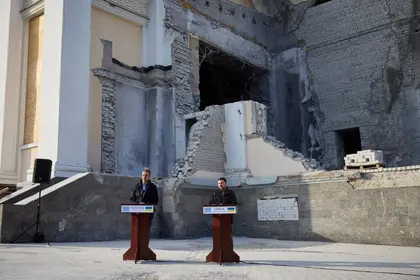On Wednesday Ukraine’s President Volodymyr Zelensky met with the Greek Prime Minister, Kyriakos Mitsotakis, in Odesa. While on a tour of the city, which has repeatedly come under missile and Shahed drone attacks, a Russian missile struck near their motorcade.
The Security Service of Ukraine (SBU) showcased its new Sea Baby unmanned surface vessel (USV), or drone, named Avdiivka to international press on Tuesday. Publicizing the new USV, produced thanks to large-scale volunterr fundraising, was from Russia’s perspective like a red rag to a bull.
JOIN US ON TELEGRAM
Follow our coverage of the war on the @Kyivpost_official.
The missile landed between 150 and 500 meters away, depending on the source, and was initially credited by some media as an attempted attack on the two leaders.
The Russian media dismissed the possibility of an assassination attempt, TASS categorizing it as “a precision strike that eliminated Ukrainian sea drones.” Russian reports couldn’t seem to agree whether the missile used was an Iskander-M ballistic missile or an Oniks anti-ship missile, or whether the target had been seaborne or airborne drones.
Shortly afterwards, the Telegram channel of the Russian Ministry of Defense announced:
“Today the Russian Armed Forces launched a high-precision missile strike on a hangar in the industrial port area of Odessa, where preparations were being made for the combat use of unmanned boats of the Armed Forces of Ukraine.”

Russia Persists With ‘Camel’ Tactic Despite Growing Drone Casualties
It went on: “The target of the strike has been achieved. The object was hit.”
Russian state media, Ria Novosti and TASS, as well as the private channel Sputnik linked the two incidents and dismissed reports by both the Ukrainian and Greek media suggesting that the leaders’ convoy was the target of the missile attack.
The local Odesa News published excerpts of a press briefing by the two leaders after the visit, during which Zelensky said that he not only heard, but also felt the impact of the strike and noticed a “mushroom cloud” of smoke.
Ria Novosti justified the near miss, claiming: “Since Oct. 10, 2022, Russian troops have been attacking energy, defense industry, military command and communications facilities throughout Ukraine.
“As President Vladimir Putin stated then, the first strike was a response to the terrorist attack carried out by the Kiev [sic] regime on the Crimean Bridge.”
They then quoted the Kremlin’s spokesman, Dmitry Peskov, as asserting that “[The Russian] army in battles with the Armed Forces of Ukrainian does not hit residential buildings or social infrastructure.”
Ukraine has neither confirmed or denied that the facility struck was linked to USV or indeed any other military capability. Odesa and the surrounding region have been repeatedly attacked with an emphasis on the role its port and those other nearby harbors play in the storage and export of grain and other food products. In addition, several important historical buildings, including its cathedral, have been the target of Russia’s air strikes.
The most recent attack on March 4 hit residential buildings, killing more than 12 civilians, including several children.
You can also highlight the text and press Ctrl + Enter










